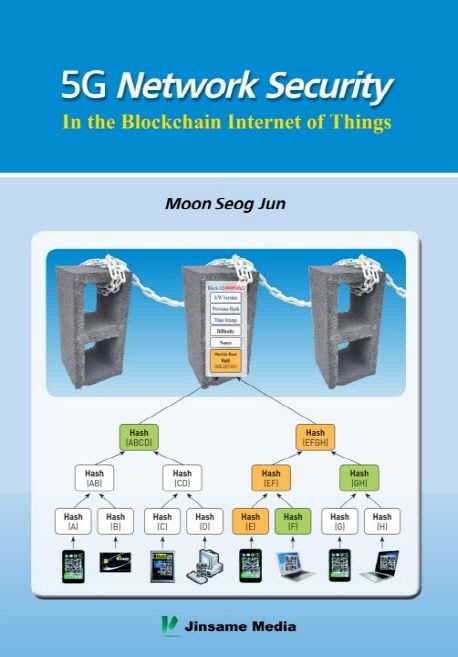서브메뉴
검색
본문
Powered by NAVER OpenAPI
-

-
5G Network Security :In the Blockchain Internet of Things (In the Blockchain Internet of Things)
저자 : Moon Seog Jun
출판사 : 진샘미디어
출판년 : 2021
ISBN : 9791191419108
책소개
Chapter 1. Introduction in Cryptography
1.1 Ancient Cryptographic Methods
1.2 B.C. 400 Scytale Cipher
1.3 Julius Caesar Cipher
1.4 Morse Codes equivalent to Computer's Binary Code
1.5 Vigenere Cipher
1.6 Pigpen Cipher
1.7 Playfair Cipher
1.8 Modern Cryptographic Technology: Enigma Machine
1.9 3-Rail Fence Transposition in Cryptography
1.10 Columnar Transposition
1.11 Running Key Cipher
1.12 One-Time Pad (OTP) Cipher
1.13 What is the Purpose of Cryptography?
1.14 References
1.15 Exercises
Chapter 2. Symmetric Cryptosystem
2.1 What is Cryptosystem?
2.2 Symmetric Key Cryptosystem
2.3 DES Algorithm
2.4 Triple DES Algorithm
2.5 AES Encryption Algorithm
2.6 Rijndael Algorithm
2.6.1 Add Round Key
2.6.2 SubByte Transformation
2.6.3 ShiftRow Transformation
2.6.4 MixColumn Multiplication
2.7 Block Cipher Operation Modes
2.7.1 ECB Mode
2.7.2 CBC Mode
2.7.3 OFB Mode
2.7.4 CFB Mode
2.7.5 CTR Mode
2.8 References
2.9 Exercises
Chapter 3. Public Key and Digital Signature
3.1 Public Key Cryptography
3.2 RSA Encryption Algorithm
3.3 A Practical Credit Card for RSA Algorithm
3.4 Diffie-Hellman Key Exchange Algorithm
3.5 Digital Signature Algorithm
3.6 RSA Digital Signature Algorithm
3.7 PGP Authentication and Confidentiality
3.8 S/MIME Algorithm
3.9 Information Security Threat Characteristics
3.9.1 Confidentiality
3.9.2 Integrity
3.9.2 Availability
3.10 References
3.11 Exercises
Chapter 4. Public Key Infrastructure (PKI)
4.1 Traditional Credit Card Payment
4.2 X.509 v.3 Certificate
4.3 Digital Certificate Verification
4.4 Hierarchical Public Key Infrastructure (PKI)
4.5 Certificate, CRL, and OCSP
4.6 Hybrid and Cross Certificate PKI
4.7 PKI Message Authentication
4.8 Wired vs. Wireless PKI Comparisons
4.9 QR Code Generation and Verification
4.10 Reed-Solomon Error Correction for QR Codes
4.11 References
4.12 Exercises
Chapter 5. Network Layer Security (Ipsec)
5.1 What is an Ipsec?
5.2 Ipsec Protocol in Network Layer
5.3 AH Protocol
5.4 ESP Protocol
5.5 Ipsec Tunnel and Transport Mode
5.6 Internet Key Exchange (IKE) Algorithm
5.7 Virtual Private Network (VPN)
5.8 IKEv2 Ipsec Protocol in IoT
5.9 References
5.10 Exercises
Chapter 6. Blockchain Security
6.1 What is a Blockchain?
6.2 What is a Merkle Tree?
6.3 Blockchain Structure in a P2P Network
6.4 Bitcoin Address and QR Code Generation
6.5 Elliptic Curve(ECC) Encryption Algorithm.
6.6 Blockchain Cryptographic Verification
6.7 Blockchain Consesus Algothm
6.8 Blockchain Internet of Things(BIoT)
6.9 References
6.10 Exercises
Chapter 7. SSL/TLS Protocol
7.1 What is a SSL/TLS Protocol?
7.2 SSL/TLS Handshake Protocol
7.3 IPSec vs SSL VPN Comparison
7.4 Wireless Transport Layer Security (WTLS)
7.5 IEEE 802.11.x Wireless (Wi-Fi) Standards
7.6 Wireless LANs (WEP, WPA, and WPA2)
7.7 References
7.8 Exercises
Chapter 8. Network Management Security (NMS)
8.1 Simple Network Management Protocol (SNMP)
8.2 SNMP Manager and Agents
8.3 SNMPv3 Engine and Application Programs
8.4 MIB and OID
8.4.1 VACM Algorithm for Access Control
8.4.2 What is the Difference Between SNMP Trap and Syslog?
8.5 Semantic RDF Graph Database for NMS
8.6 References
8.7 Exercises
Chapter 9. Intrusion Detection System (IDS)
9.1 What is an Intrusion Detection System (IDS)?
9.2 Host-based and Network-based IDS
9.3 Misuse-based and Anomaly-based IDS
9.4 Snort Intrusion Detection System
9.5 Other Intrusion Detection System(IDS) Tools
9.5.1 Kismet IDS
9.5.2 Zeek IDS
9.5.3 Open Data Loss Prevention (DLP) IDS
9.5.4 Sagan IDS
9.5.5 Security Onion IDS
9.6 References
9.7 Exercises
Chapter 10. Virus and Anti-Virus Codes
10.1 What is a Computer Virus?
10.2 Computer Worm Virus
10.3 Trojan Horse Virus
10.4 Backdoor Virus
10.5 Botnets Virus
10.6 Malware Infection Route and Symptoms
10.7 Anti-Virus Treatment System
10.8 Distributed Denial of Service (DDoS)
10.9 Advanced Persistent Threat (APT)
10.10 References
10.11 Exercises
Chapter 11. Firewall Systems
11.1 What is a Firewall System?
11.2 Packet Filtering
11.3 Network Address Translation (NAT)
11.4 Application Layer Firewall
11.5 Firewall Confiration
11.5.1 Packet Filtering Firewall
11.5.2 Dual Homed Firewall
11.5.3 Screen Host Firewall
11.5.4 Screen Subnet Firewall
11.6 Packet Penetration Tools for Auditing Firewall
11.6.1 Hping3 Tool
11.6.2 Traceroute Tool
11.6.3 Nmap Tool
11.6.4 Netcat Tool
11.7 Common Criteria (CC) Assurence Levels
11.8 References
11.9 Exercises
Appendix: INDEX
목차
Network Security, based on the lecture notes and experience gained
from 30 years of university lectures, explains all aspects of information security from basic to advanced encryptions (AES, RSA), Authentication, Blockchain, and the Internet of Things (IoT) through Figures.
This book is composed of 11 Chapters centering on lots of Figures
explained to Network Security, and is written based on the university
lecture Syllabus. In each chapter, Figures summarizing the whole is written at the beginning, focusing on Network Security Contents rather than difficult theories, and is explained in the easiest way to understand for beginner students in all fields. This book includes the Internet of Things Security, Public Key Infrastructure (PKI), Blockchain Security, IPsec, SSL, and web security services.
* Explain the new Figures of Public Key Certificate and PKI in the Internet of Things
* Introduction of Blockchain IoT and application security fields
* Intrusion-Detection Systems (IDS), Viruses, and Firewall system structures.
* Web site for instructor and student support www.ijcsns.org